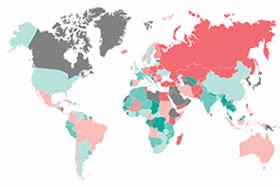1997 was the year with the highest number of HIV infections worldwide. Since then, the number has decreased by 40%, but this positive trend has now come to an end. A recently published UNAIDS report confirms that the number of yearly infections has not declined in the last five years.

Every year, approximately 1.9 million persons were infected. UNAIDS is calling for more prevention efforts.
Key populations
In some regions, such as the Caribbean or Eastern Europe and Central Asia, the number of infections has increased, in the latter by 57%, between 2010 and 2015. One of the reasons why the number of infections is not decreasing is the lack of attention for key populations, i.e. groups of people who run a higher risk of acquiring the virus, such as men who have sex with men, sex workers and people who inject drugs. These populations represent 35% of the number of new infections.
“The issue is access”
Twenty years ago, the number of HIV prevention options were rather limited. Now, people can choose from a broader spectrum, from condom use and circumcision, to treatment with HIV-medication as prevention. Unfortunately, key populations and young people often experience a lack of access to HIV services. “’Access’ is the issue”, according to UNAIDS director Michel Sidibé. “The issue is access — if people do not feel safe or have the means to access combination HIV prevention services we will not end this epidemic.”
Download the UNAIDS report
Key populations
In some regions, such as the Caribbean or Eastern Europe and Central Asia, the number of infections has increased, in the latter by 57%, between 2010 and 2015. One of the reasons why the number of infections is not decreasing is the lack of attention for key populations, i.e. groups of people who run a higher risk of acquiring the virus, such as men who have sex with men, sex workers and people who inject drugs. These populations represent 35% of the number of new infections.
“The issue is access”
Twenty years ago, the number of HIV prevention options were rather limited. Now, people can choose from a broader spectrum, from condom use and circumcision, to treatment with HIV-medication as prevention. Unfortunately, key populations and young people often experience a lack of access to HIV services. “’Access’ is the issue”, according to UNAIDS director Michel Sidibé. “The issue is access — if people do not feel safe or have the means to access combination HIV prevention services we will not end this epidemic.”
Download the UNAIDS report

 RSS Feed
RSS Feed